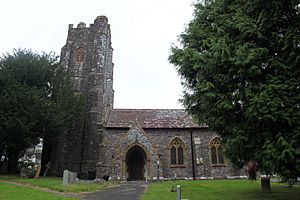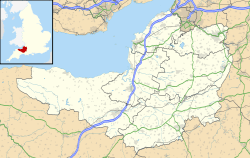Church of All Saints, Chipstable facts for kids
Quick facts for kids Church of All Saints |
|||||||||||||||||
|---|---|---|---|---|---|---|---|---|---|---|---|---|---|---|---|---|---|
 |
|||||||||||||||||
| 51°02′08″N 3°22′00″W / 51.0356°N 3.3667°W | |||||||||||||||||
| OS grid reference | ST042271 | ||||||||||||||||
| Location | Chipstable, Somerset | ||||||||||||||||
| Country | England | ||||||||||||||||
| Denomination | Anglican | ||||||||||||||||
| Website | |||||||||||||||||
The Church of All Saints is an Anglican church located in a village called Chipstable in Somerset, England. It's a very old building, likely built in the early 1200s. This church is a special historical building, officially listed as Grade II*. This means it's considered very important and needs to be protected. ContentsWhat the Church is Used ForThe Church of All Saints is part of the Church of England. It works together with several other churches around the town of Wiveliscombe. This group of churches is known as "Wiveliscombe and the Hills." They all share the same priest, who helps lead services and activities for everyone. The church is part of the Tone deanery and the Diocese of Bath and Wells, which are like different levels of organization within the Church of England. A Look Back in TimeThere has been a church in Chipstable for a very long time. Records show that a church was here even before the 11th century. It was even mentioned in the Domesday Book, which was a huge survey of England made in 1086! The first known priest, or "rector," of Chipstable was named Stephen, and he was here in 1248. For many years, the monks from Muchelney Abbey looked after the Church of All Saints. This continued until 1538, when King Henry VIII closed down many monasteries in England during an event called the Dissolution of the Monasteries. The Church of All Saints was officially dedicated in 1531. Building the ChurchThe church's tower is very old. Some people believe it was built around 1239, while others think it's from the 15th century. The top of the tower looks like a castle wall, with battlements, which is called "crenellated." It also has beautiful stone carvings of angels on each of its four sides. Most of the main part of the church, called the nave, was rebuilt in 1869. The builders used red sandstone and a lighter stone called hamstone for decorations. They even reused some of the original stones from the older building. The nave has two side sections, called aisles, and a porch at the south entrance. The doorway of the porch is from the 15th century, but the actual door is newer, from the 1800s. The church building combines two old English architectural styles: Decorated and Perpendicular Gothic. These styles are known for their detailed stone work and tall windows. The bell tower originally had five bells, but a sixth bell was added in 1901. Inside the church, you can still see two old wooden bench ends from around 1530. One has a carving of a pestle (a tool for grinding), and the other shows a huntsman. Next to the church, there was once a rectory, which is the house where the priest lived. The original rectory was built in the early 1600s and was rebuilt and made bigger in 1870. It was sold about 100 years later and is now a private home called "The Grange." A new rectory for the priest was built in 1975. Churchyard TombsIn the churchyard, there are three old stone tombs called chest tombs. These are also listed as Grade II historical structures. The oldest one is from the 1600s, though it was changed a bit in the 1700s. The other two are from the 1700s and 1800s. When they were last surveyed, they were a bit damaged and covered in plants. You can still see the name John Hastings on the oldest tomb, but the writing on the others is too faded to read. See also
|
|||||||||||||||||


